Walking in the Dark
- Patricia Sonnino and Marsha Balian at the Gearbox Gallery
- October 16 through November 14, 2020
- Fridays and Saturdays, noon to 5:00 p.m.
So I think I’ll begin by quoting from your website statement, in part, “[Sonnino]…explores how shapes build a painting, how color moves it, and how pattern and marks create air and time.” [We immediately took a detour to talk about the UCross Residency Patricia had just returned from. https://www.ucrossfoundation.org/residency-program.html.]
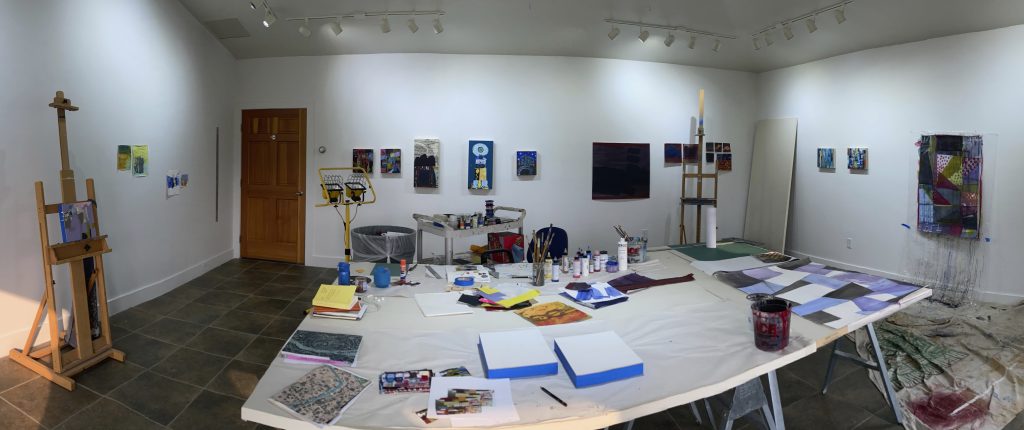
Oh my god, it was great. There were only four of us due to the virus; each of us had a building to live in and a building to work in. We had one composer in residence who was completely fabulous [Andy Akiho: https://en.wikipedia.org/wiki/Andy_Akiho] It was so beautiful there. The sky…. you know, it is one of the darkest places in America, so the sky was just amazing. You can see the Milky Way so clearly. It’s hard to distinguish constellations; you’re seeing so many stars and planets. I saw Jupiter, Mars, and Saturn. It was so perfect for right now [this time of uncertainty and anxiety].
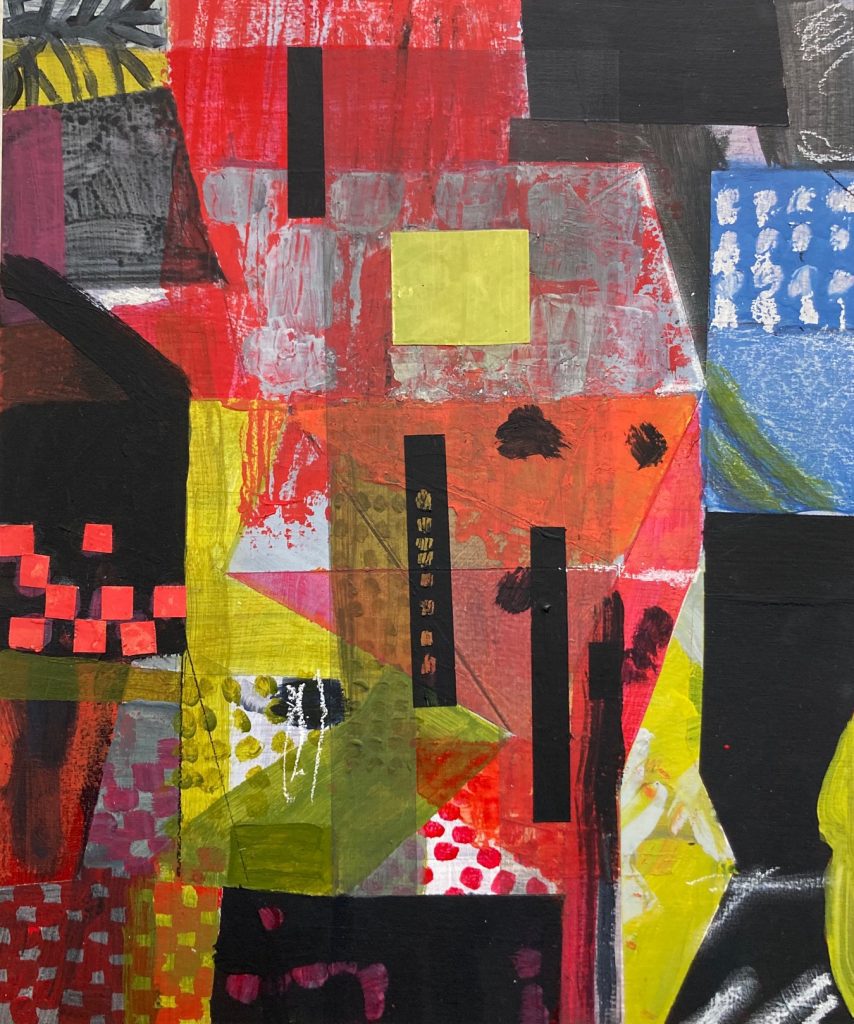
Have you seen that television series, “Midnight Diner?” [https://en.wikipedia.org/wiki/Midnight_Diner_(Japanese_TV_series)] They’re driving down a roadway in Shinjuku and it is very chaotic and everything is vertical so you have the sense of looking through layers. This painting is a kind of excavation, a painting that’s telling its own history. This is the closest I think I’ve come to where you can see there is something underneath that then got covered up and changed. Yes, there are elements of collage in this one. The yellow-green square and the little red squares are applied painted paper. It is a technical thing for me. Even though I am still using hard-edged shapes, there are all sorts of markings that create layers.
So how did you approach the work you did at the Residency?
I had anticipated being there and that it was a lot of landscape, mountains, open land, and patterns. I knew that the night sky was spectacular. I was thinking about night and what are night colors in the dark. In Proust’s Swan’s Way, it begins with him waking in the dark and he goes through recognizing all the rooms he’s slept in and trying to figure out which one he’s in. So I was thinking, everything looks different in the dark. What would that be like, in these chaotic and anxious times we are in, orienting one’s self, trying to find your place, and what sort of forms you would attach to it?
[The work done at UCross seemed to me to be a natural extension of the work Patricia painted for the Gearbox Gallery exhibit.]
I type really small and I typed “Waking in the Dark” but Marsha [Marsha Balian, co-exhibitor] read it as “Walking in the Dark” and so we decided on that for the title of the exhibit.
So looking at this group of paintings for the exhibit, they are all tied in a way to the natural world, to the landscape. When I first looked at this group of paintings it occurred to me that they all had something to do with architecture and landscape, of architecture in landscape. And the design, the compositions, are so solid.
I was educated as an architect. But I always wanted to be a painter. I would meet architects and they would say things like, “Oh, I used to draw… [sadly]” and it terrified me and so I never did stop. I was an architectural designer so most of my time was spent drawing. And I was always the go-to color person. So your eye gets trained to see things in a certain way.
The rectangular paintings recall architectural friezes which imply a narrative to me because they’re long and your eye moves from left to right, not unlike early comic books in which the narrative moves from frame to frame. [Yes, your eye travels across it. And it’s interesting from a cultural standpoint because, for example, Japanese horizontal scrolls are “read” from right to left…. A long discussion ensued about the differences of perception between Western and Eastern aesthetics.]
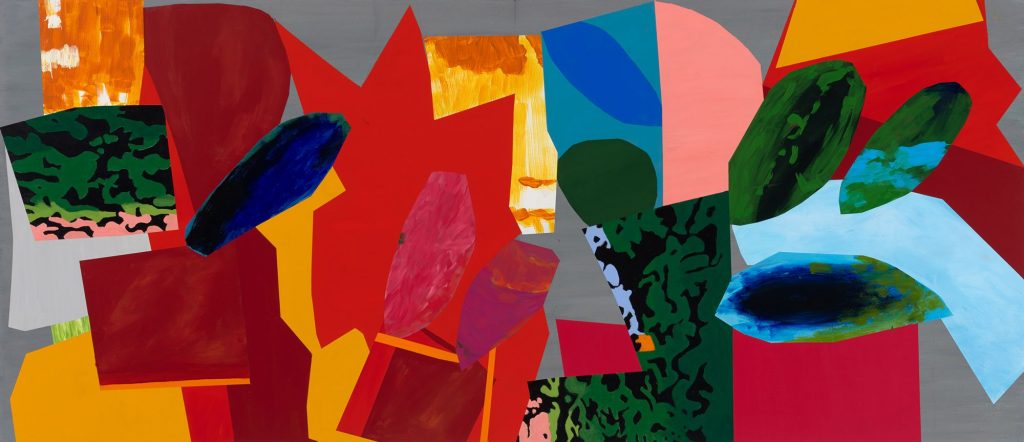
The titles of your paintings inform me. They are mostly anchored in the earth and in things having to do with geology and there’s a sort of time thing going on, a geological time reference, like Equinox in a Foreign Landscape, Hydrosphere, and Rift. Let’s talk about Hydrosphere [The hydrosphere is the combined mass of water found on, under, and above the surface of a planet, minor planet, or natural satellite. Although Earth’s hydrosphere has been around for about 4 billion years, it continues to change in shape. Wikipedia]
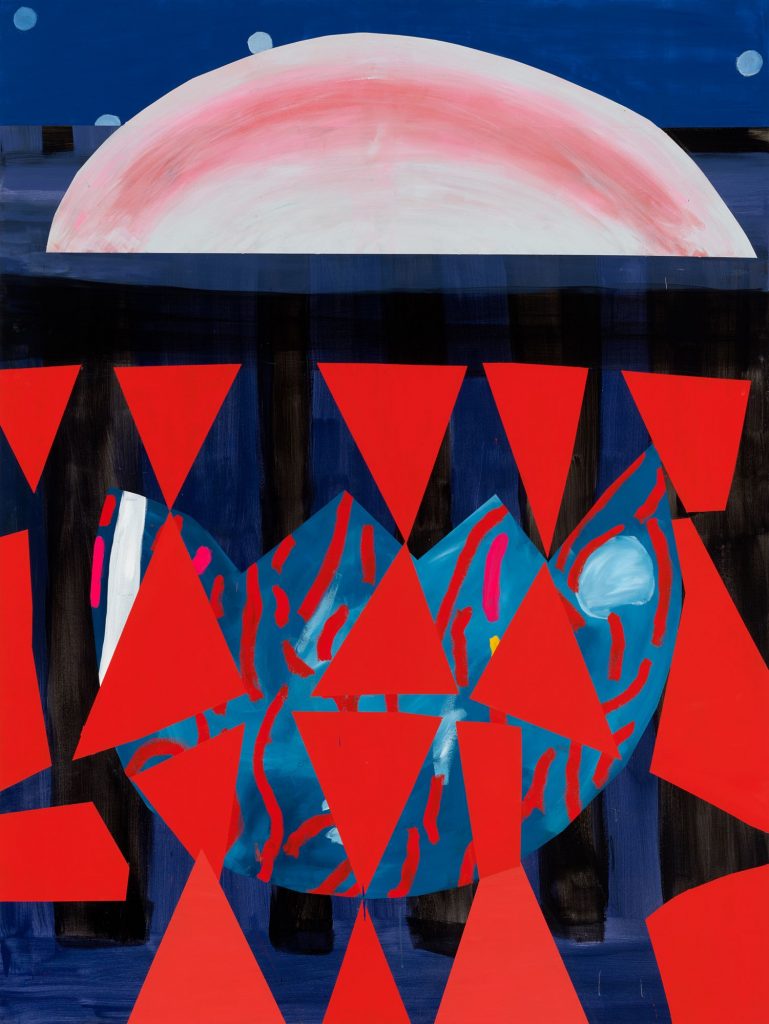
This one is on canvas because it got beyond the size that I could carry [Discussion about scale]. I painted the entire background first. It’s painted in layers. I was thinking about what’s not visible to us, being in invisible cities, like a world that is mirrored. Some people are living in one city but there is a mirrored city beneath it, like the opposite, or that there is something weird about it, like in Calvino’s invisible cities where some worlds are mirrored. [Short discussion about Invisible Cities, by Italo Calvino. https://en.wikipedia.org/wiki/Invisible_Cities] I guess it has to do with the anxiety and disconnection that I’m feeling right now. I think that, especially with climate change, there is so much invisible to us that’s happening. I do think about water a lot when I’m here, in San Francisco. [Patricia’s home and studio are in San Francisco]. What percentage of the earth is water? What is happening above and below? It’s about trying to look beneath the surface to see what’s underneath. That’s why geology is fascinating, like when the earth moves and suddenly you see something you’re not meant to see.
I’d like to talk about your process. Let’s go to Cairn to Mark Unknown Territory. It’s different in some ways from the other paintings in this series. The color palette is different. But again, it’s tied to the landscape. [A cairn is a man-made pile of stones. The word cairn comes from the Scottish Gaelic: càrn. Cairns have been and are used for a broad variety of purposes, from prehistoric times to the present. In modern times, cairns are often erected as landmarks, a use they have had since ancient times. Wikipedia]. When you began this painting did you have an idea of doing something about a cairn?

No, I didn’t begin it with that idea. 2020 for me has this pervasive feeling of being up in the air and losing your bearings and so I thought, “How do I orient myself?” and cairns and totems came to mind. I usually work off of really small things. I make collages to get started. I have a designer’s brain and I have to turn it off. When I work on something simple, not precious, like a sketch or simple collage, I can turn off that part of my brain. Whereas, if I face a big, blank canvas, every brushstroke becomes something important and I over-analyze it. So I trick myself by doing fast and quick things and then execute them on a bigger form. Where I want to get is somewhere where you can find the history of the painting in the painting [I underlined this for emphasis]; there is something that lies beneath, that was erased, in the building of the painting, and I’m trying to find a way to capture some of that so you can detect the entire process. So, for example, there is a background and a foreground and you typically think of the background having been painted first but sometimes I reverse that. And the hard-edged forms give shapes that I like. I tape them to paint them and I like the edges I get. [So the lines or linear markings are sort of juxtaposed with the solid shapes?]. Yes. The taping provides structure and then you can do whatever you want in it but it still retains its structure.
Let’s go to Totem for the Night Sky. One thing I’ve noticed in this one and in some others is the sort of sketchy linear areas like we see on the right side of this painting.
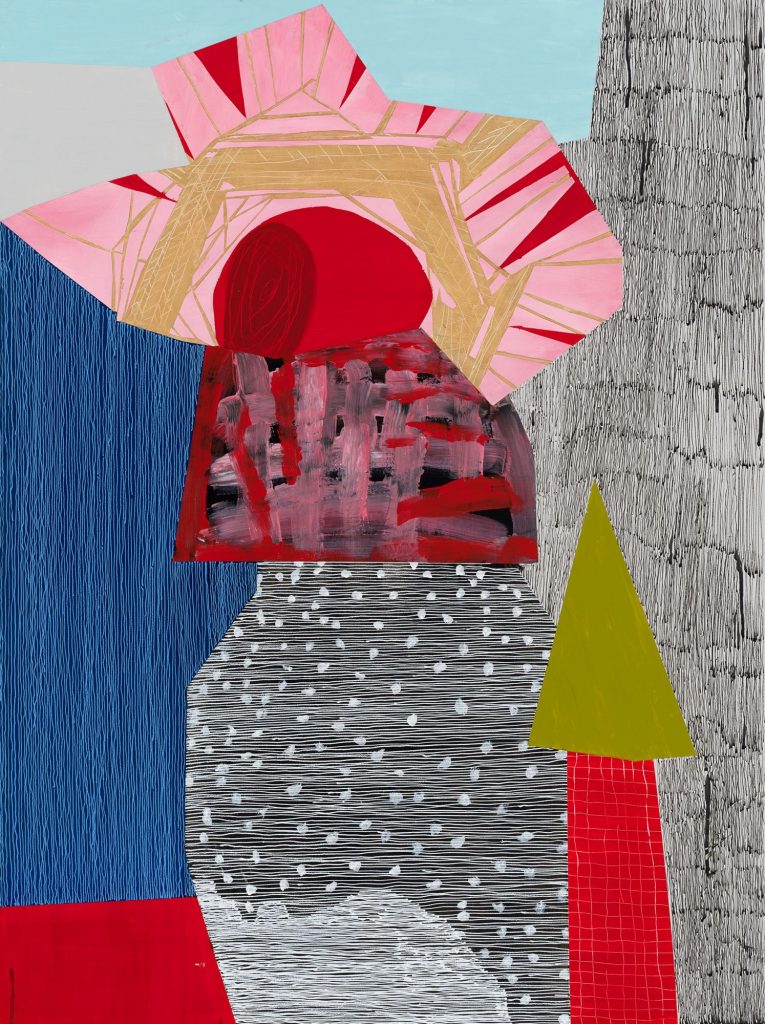
I just like making marks. It marks time for me. Speed is not essential. The slower I can paint, the better, especially these days when paintings have no place to go. I like making patterns that mark time. And then there are these great accidents, like dripping, that give it more character. These small marks [sketchy linear marks] give a large piece a bit of air. When you’re working with solid shapes and hard edges you need air in the painting and this is a way for me to do that, to let it breathe.
I also curiously see this painting as a figure.
Yes, that’s totally fair. I do see some of these as figures and totems often are figures.
Let’s talk about Walkabout.
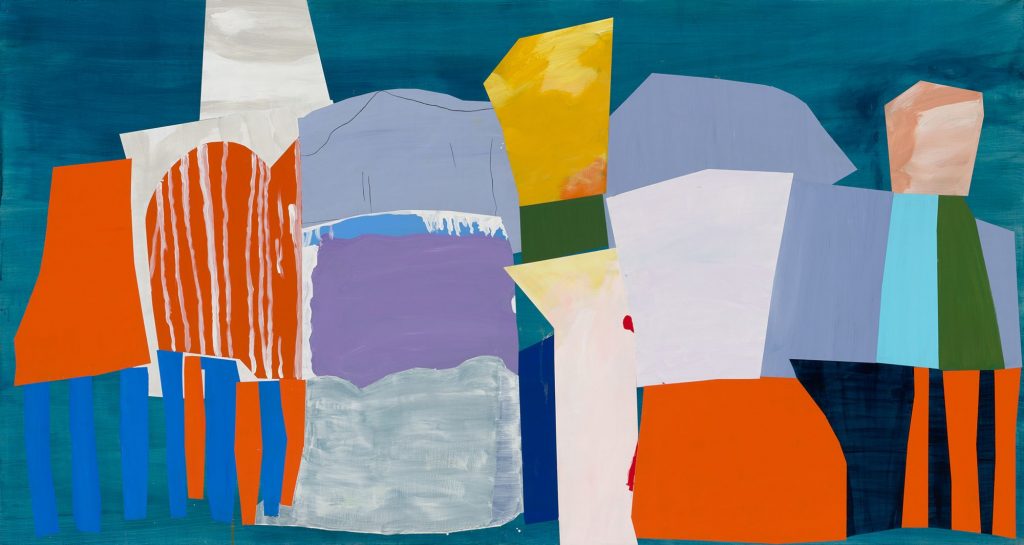
With the legs [laughter]; so many legs! [We had a lengthy discussion about Australian Aboriginal art, in particular the painting of Emily Kngwarreye. https://en.wikipedia.org/wiki/Emily_Kame_Kngwarreye]. What I really like about some of her [Kngwarreye’s] work is the transparency in them. In this piece, I was thinking about a landscape with figures in it and all the little legs there for a rhythm. So it’s landscape and figurative and it’s moving so I thought it’s a walkabout. [Conversation regarding how the painting moves.] It moves in a circle for me. It goes from left to right with those legs but then I hit that green spot and it begins going backward. I was very conscious about balancing the color and moving your eye around the painting. It sort of drifts. The two vertical white forms tie it down a bit but otherwise, it’s like floating.
So tell me about the two little red markings.
I feel like they’re really important. [Discussion about minimalist hard-edge vs painterly painting and the crossover between the two, with reference to Agnes Martin. https://en.wikipedia.org/wiki/Agnes_Martin]. When I went to the Agnes Martin exhibit in LA there was this big, beautiful, blue piece. The two guards in the gallery were talking about it and I asked them what they thought and this little guard – young guard, she had dark black hair with this pink streak in the back of it – said that earlier that day a woman had come in and sat down to look at the painting and began crying. So she, the guard, was determined to sit there and determine why the woman had been crying. So she went and sat and I have a photo of her from the back, sitting and looking at the painting. It’s so great.
[We had a long discussion about acrylic vs oil paints including the surface quality and some of the environmental concerns.] Yes, I want to go back to working with oils. For one thing, I love the smell of oils.
Oh good! Well, one of the things about being an artist now is that we have so many options.
So I always end these interviews with a question that came about because I constantly ask it of myself. It is rather simple and perhaps odd but I’ll ask it anyway. The question is, “Why do you do it?”
Oh, because I have to. I was really young when I decided I had to have some sort of purpose and it wasn’t going to be religion and it wasn’t going to be this or that and painting has been the thing. It has gotten me through so much. I literally don’t know what I would do with myself or why I would think I was alive if I didn’t paint.
When I used to meet new people and they’d ask me what I did and I’d say, “I’m a painter,” they always assumed I was a house painter. [Laughter] And I probably would have made a lot more money doing that!
I think about it mostly from the point of view of why do I want to add stuff to this world that is so struggling. If ever I move from this studio I am in, which just seems like a horrendous task, I would open the doors and let people come in and take everything.
Promise to let me know when you do that!
https://www.patriciasonnino.com
